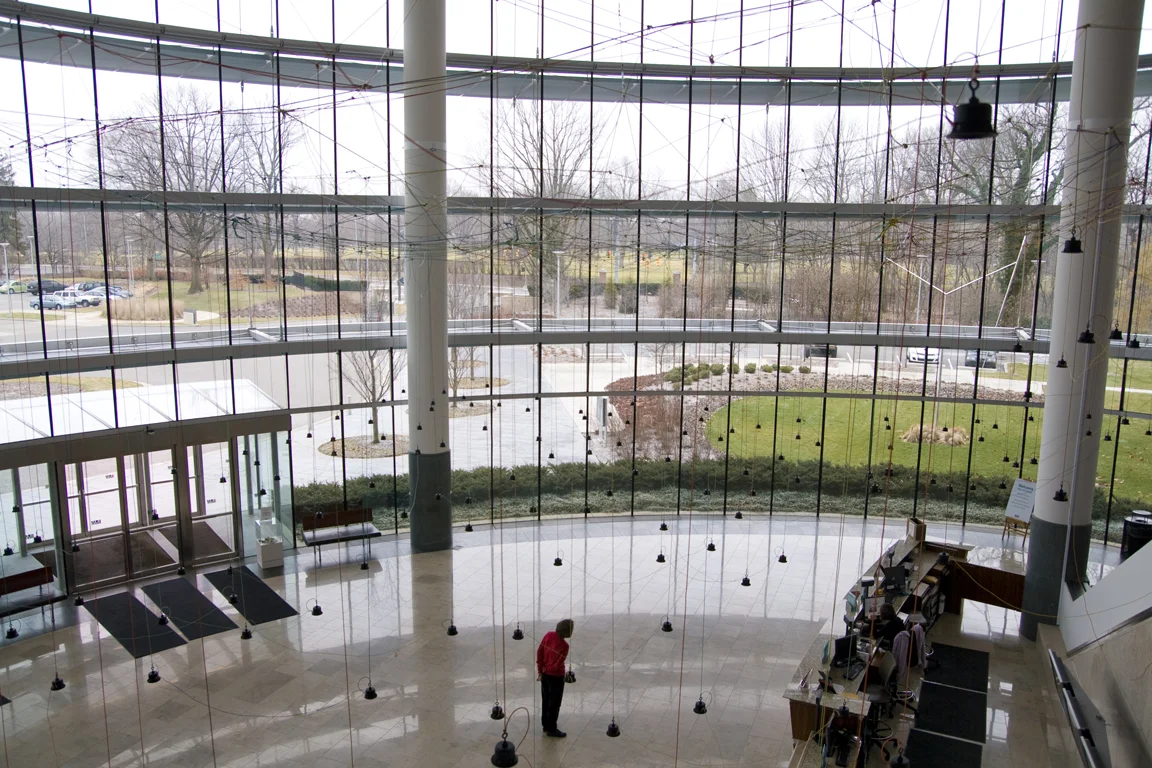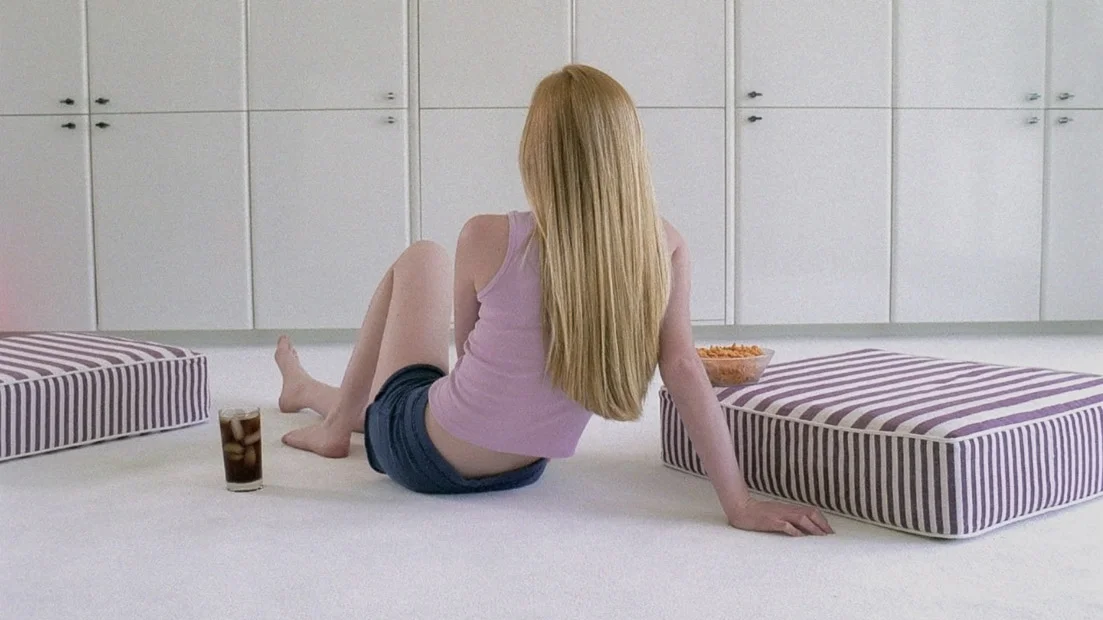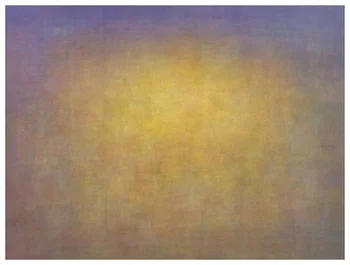Terrain
Image courtesy of http://www.imamuseum.org/blog/2008/02/26/the-anatomy-of-a-video-project/
What does a forest of speakers whispering words of love feel like? Julianne Swartz’s Terrain, created in 2008, reminds us that love is beautiful, ungraspable, and contagious with a forlorn feeling when it fades away. Participants walk into a room filled with suspended speakers. As one navigates through the speakers, whispering words and the soft hums of songs can be heard as if voices are whispering in your ear. Each speaker contains an individual arrangement of whispers, which allows the participant to have a unique sound experience. The artist invited volunteers to whisper phrases that they would say to their loved ones, which were recorded and played through an arrangement of speakers in a sonic landscape. In addition to loving phrases, volunteers were asked to hum softly any songs that came to mind as they thought of those close to them. The effect of the installation resembles an animated electronic forest filled with the words of unseen ephemeral entities.
“In Julianne Swartz’s sound installation, breathing, humming, and whispered messages of love in English, Spanish, Korean, Hebrew, Polish, Croatian, Japanese, Greek, French, and Chinese meld together, to generate sounds like blowing wind, rushing water or rustling leaves.”
The sounds themselves in Terrain become sculptural elements in the installation, animating small speakers in the otherwise empty space. These voices contain a feeling of tangibility as one walks through a forest of words. Similar to Swartz’s use of voices as sound sculpture is the installation, Raw Materials, by Bruce Nauman in 2004, consisting of twenty-two voice works that were collected from over forty years of his career. Walking through the Turbine Hall at Tate Modern, voices emerge and recede, emitted from white speakers along the walls. The voices mutate as they recite repetitive phrases, changing in volume and intonation. The subtle changes in combination with the repetitive process morphs the meaning of the words as they’re reformulated over and over. The effect is both repelling and captivating.
Image courtesy of http://www.artnet.com/Magazine/reviews/douglas/douglas10-27-1.asp
“Throughout, the tone of voice, the inflection, and variations in rhythms dramatically shift meanings, from diplomatic to psychotic, pleading to bullying, anxiety to mockery”
Kindred to Swartz’s Terrain, Nauman’s Raw Materials embody sculptural sound, as the sound waves encompass the space and positioned in a way that creates a sense of dimensional auditory volume. Both installations utilize recorded voices as a central auditory medium of exploration in the work. A central difference in these pieces is that the content of the voices in Nauman’s Raw Materials has a very divergent message from Swartz’s Terrain. The voices in Raw Materials contain visceral tones of antagonism, evoking reactions of anxiety and surprise in listeners upon hearing the words. In Terrain, the intent is the opposite through whispered messages of love and respect transposed in a way that is hauntingly fleeting in ephemerality.
Image courtesy of http://sound-art-text.com/post/106254788138/yesno-questions-is-an-installation-by-guy
Guy Goldstein’s Yes/No Questions installation contains twelve amplifiers that project voices speaking the phrases of yes or no in several languages. The faces of the amplifiers are covered with vellum reminiscent of leather drumheads. The voices speak through the amplifiers, spraying ink blotches onto the vellum through sound waves, (everydaylistening.com). The vocal sound waves create unusual visceral ink patterns on the face of the amplifiers over time. Similar to Swartz’s Terrain, Goldenstein is using voice recordings in several languages to create a sculptural soundscape. Analagous to Terrain, the speaker devices in Yes/No Questions have a sculptural presence that dominates the space filled with invisible sound waves. The difference between these works lies in the intention of the voices. Goldstein utilizes conflicting messages of yes and no from several languages to conceptually address political strife between regions. The sound waves staining the face of the amplifiers seems to almost injure the devices as words are spoken, metaphorically describing the violence that results from these conflicts. The words in Terrain are intended with benevolence, mixed with a haunting sadness that the words are momentary in their whispered temporality.
“Terrain’s relatively simple technology creates a flow of sound that suggests the fragility of life and the ephemeral nature of communication.”
Though the fleeting words in Terrain may seem soft hearted on the surface, there is a subversive quality to the phrases. Positive messages reminding people that they are loved and have value emphasizes communal connection over the prevalent individualist isolationism of the modern era. Living in a society that flourishes on not being good enough with constant competitive comparisons of inadequacy, the loving words emitted through speakers challenge these belief systems. The positive messages emit an ideal that, on some level, confront this cultural deprivation. Positive messaging is a powerful way of transforming collective values. For instance, if we believe that we are loved and valued for who we are, how would that change the way we spend money, make life goals or select leadership? In Terrain, Julianne Swartz reminds us of something our society deeply needs, love.
References:
http://www.imamuseum.org/exhibition/julianne-swartz-terrain
http://www.julianneswartz.com/work_archive/terrain/terrain.html
https://www.youtube.com/watch?v=mRcXDdJ0XGI
http://www.aptglobal.org/en/Exhibition/25551/Julianne-Swartz-Terrain
http://www.julianneswartz.com/work_archive/terrain/press/2009-Artforum_JS.jpg
http://www.everydaylistening.com/articles/tag/soundart?currentPage=3
http://sound-art-text.com/post/106254788138/yesno-questions-is-an-installation-by-guy








